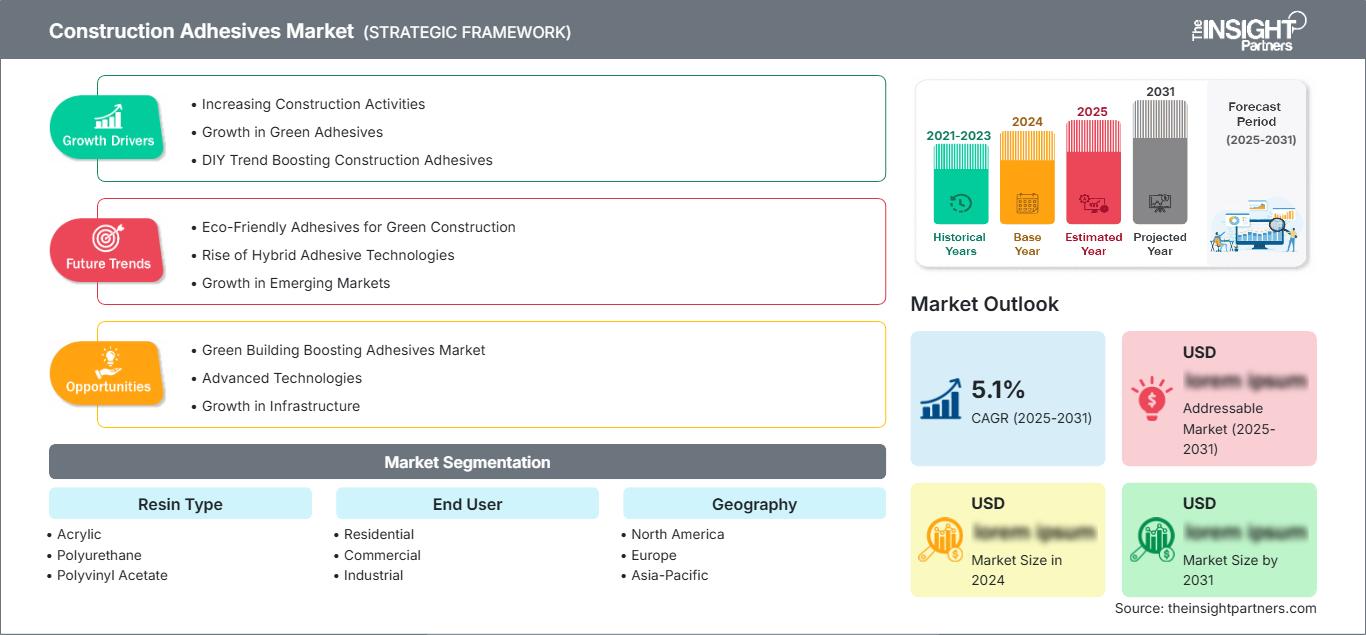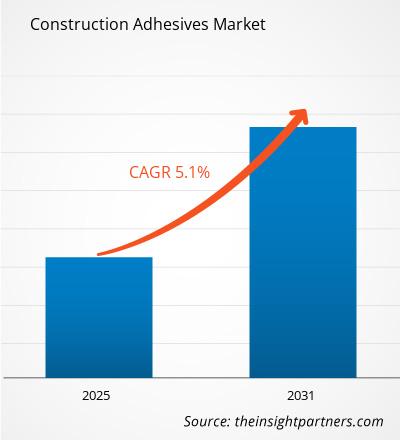页面已更新 :
Jan 2025
预计到2031年,建筑粘合剂市场规模将达到161.7亿美元。预计2025年至2031年期间,该市场将以5.3%的复合年增长率增长。
本报告按树脂类型(丙烯酸树脂、聚氨酯树脂、聚醋酸乙烯酯树脂、环氧树脂树脂及其他树脂)和最终用户(住宅、商业、工业及其他)进行细分。报告涵盖五大区域:北美、欧洲、亚太、中东和非洲以及南美和中美洲,并重点关注各区域的主要国家。全球分析进一步细化至区域和主要国家层面。报告以美元为单位,提供上述分析和细分市场的价值。
报告目的
The Insight Partners发布的《建筑粘合剂市场报告》旨在描述建筑粘合剂市场的现状和未来增长趋势,包括主要驱动因素、挑战和机遇。该报告将为各类商业利益相关者提供参考,例如:
- 技术提供商/制造商:了解不断变化的市场动态和潜在的增长机会,从而能够做出明智的战略决策。
- 投资者:对市场增长率、市场财务预测以及整个价值链中存在的机会进行全面的趋势分析。
- 监管机构:监管市场政策和执法活动,旨在最大限度地减少滥用行为,维护投资者信任和信心,维护市场的诚信和稳定。
建筑粘合剂市场细分:树脂类型
- 丙烯酸纤维
- 聚氨酯
- 聚醋酸乙烯酯
- 环氧树脂
最终用户
- 住宅
- 商业的
- 工业的
根据您的需求定制此报告
您可以免费获得任何报告的定制服务,包括本报告的部分内容、国家/地区层面的分析、Excel 数据包,以及面向初创企业和高校的优惠折扣。
建筑粘合剂市场:战略洞察

- 获取本报告的主要市场趋势。这份免费样品将包含数据分析,内容涵盖市场趋势、估算和预测等。
建筑粘合剂市场增长驱动因素
- 建筑活动日益增多:建筑胶粘剂市场受到各地建筑活动日益增长的推动,尤其是在城市化和基础设施建设的推动下。随着越来越多的房屋、办公室和工厂拔地而起,对高效粘合系统的需求也随之增加,因此,旨在增强结构强度的现代胶粘剂应运而生。(报告范围)
建筑粘合剂市场区域洞察
The Insight Partners 的分析师对预测期内影响建筑粘合剂市场的区域趋势和因素进行了详尽的阐述。本节还探讨了北美、欧洲、亚太地区、中东和非洲以及南美和中美洲的建筑粘合剂市场细分和地域分布。
建筑粘合剂市场报告范围
最终用户- 住宅
- 商业的
- 工业的
- 英国
- 德国
- 法国
- 俄罗斯
- 意大利
- 欧洲其他地区
- 中国
- 印度
- 日本
- 澳大利亚
- 亚太其他地区
- 巴西
- 阿根廷
- 南美洲和中美洲其他地区
- 南非
- 沙特阿拉伯
- 阿联酋
- 中东和非洲其他地区
报告属性 细节 2024年市场规模 XX亿美元 到2031年市场规模 161.7亿美元 全球复合年增长率(2025-2031年) 5.3% 史料 2021-2023 预测期 2025-2031 涵盖部分 按树脂类型 - 丙烯酸纤维
- 聚氨酯
- 聚醋酸乙烯酯
- 环氧树脂
覆盖地区和国家 北美 - 我们
- 加拿大
- 墨西哥
市场领导者和主要公司简介 - 3M公司
- 巴斯夫集团
- 汉高股份公司
- 波士基
- 西卡集团
- DAP产品
- 道康宁
- HB Fuller
- 伊利诺伊工具公司
建筑胶粘剂市场参与者密度:了解其对业务动态的影响
受终端用户需求不断增长的推动,建筑胶粘剂市场正快速发展。终端用户需求增长的驱动因素包括消费者偏好的转变、技术的进步以及消费者对产品优势的认知度提高。随着需求的增长,企业不断拓展产品线、创新以满足消费者需求并把握新兴趋势,这些都进一步推动了市场增长。

- 获取建筑粘合剂市场主要参与者概览
- 历史分析(2 年)、基准年、预测(7 年)及复合年增长率
- PEST和SWOT分析
- 市场规模、价值/数量 - 全球、区域、国家
- 行业和竞争格局
- Excel 数据集
近期报告
相关报告
客户评价
购买理由
- 明智的决策
- 了解市场动态
- 竞争分析
- 客户洞察
- 市场预测
- 风险规避
- 战略规划
- 投资论证
- 识别新兴市场
- 优化营销策略
- 提升运营效率
- 顺应监管趋势
我们的客户































87-673-9708

ISO 9001:2015



 获取免费样品 - 建筑胶粘剂市场
获取免费样品 - 建筑胶粘剂市场